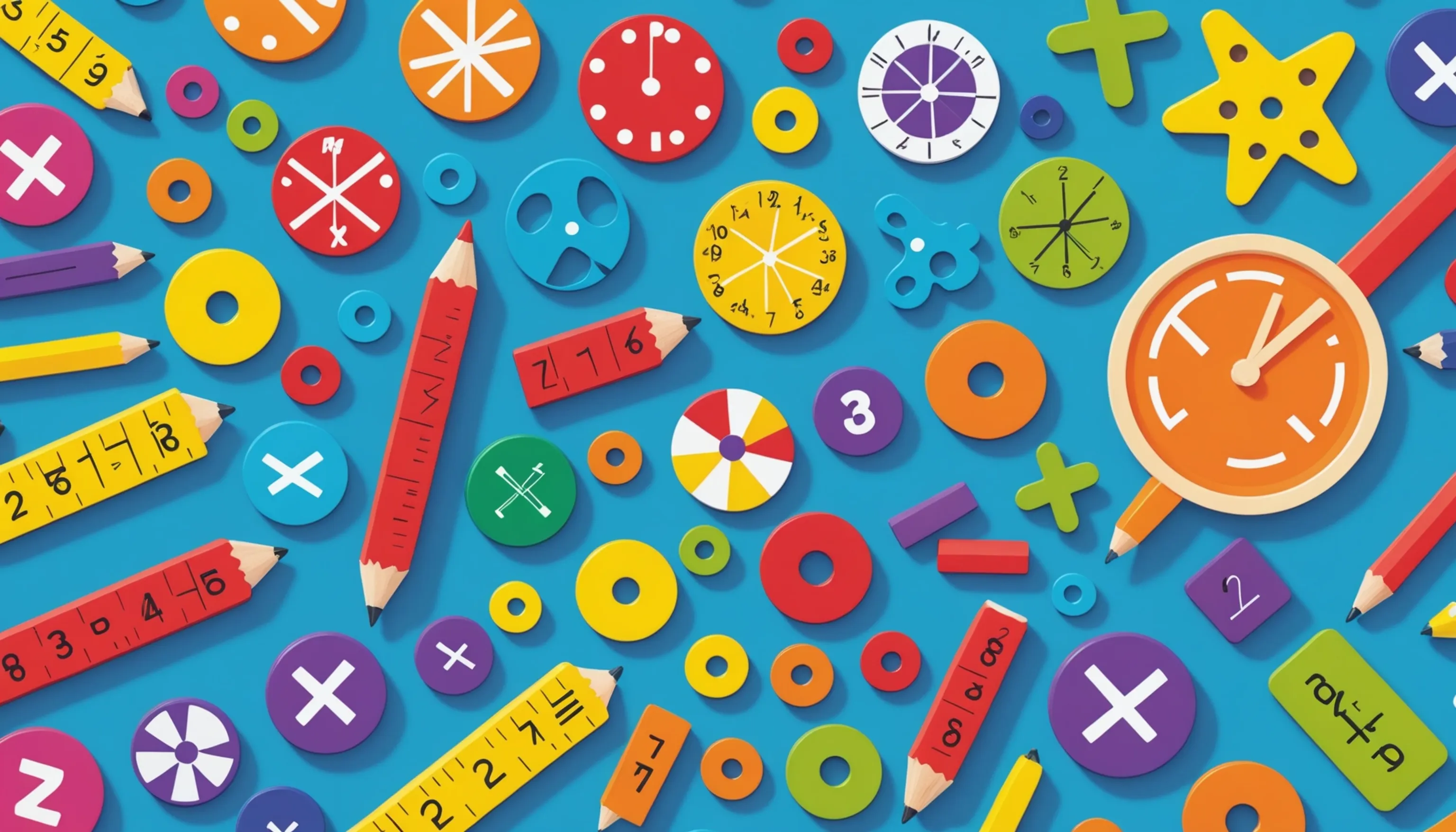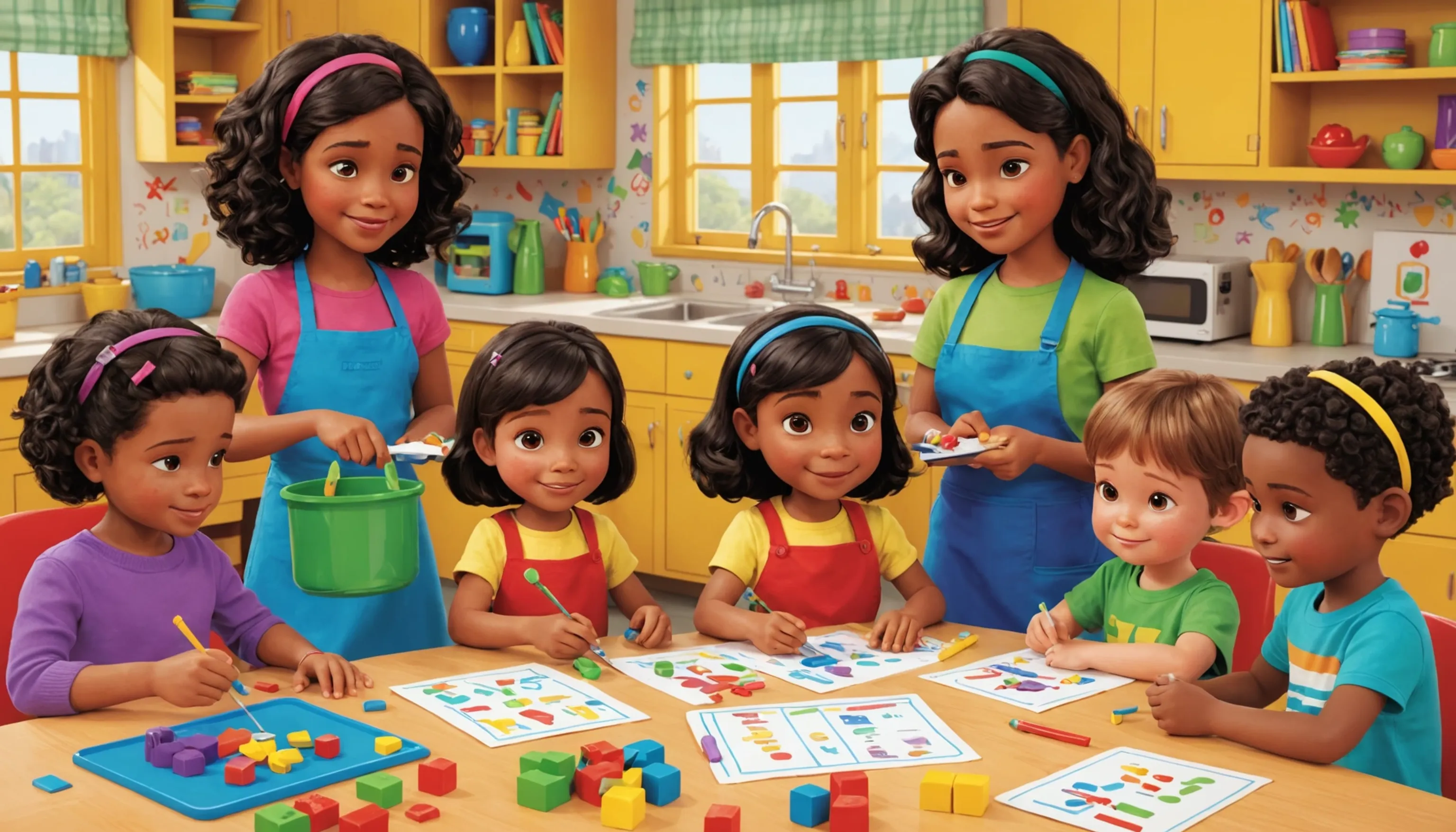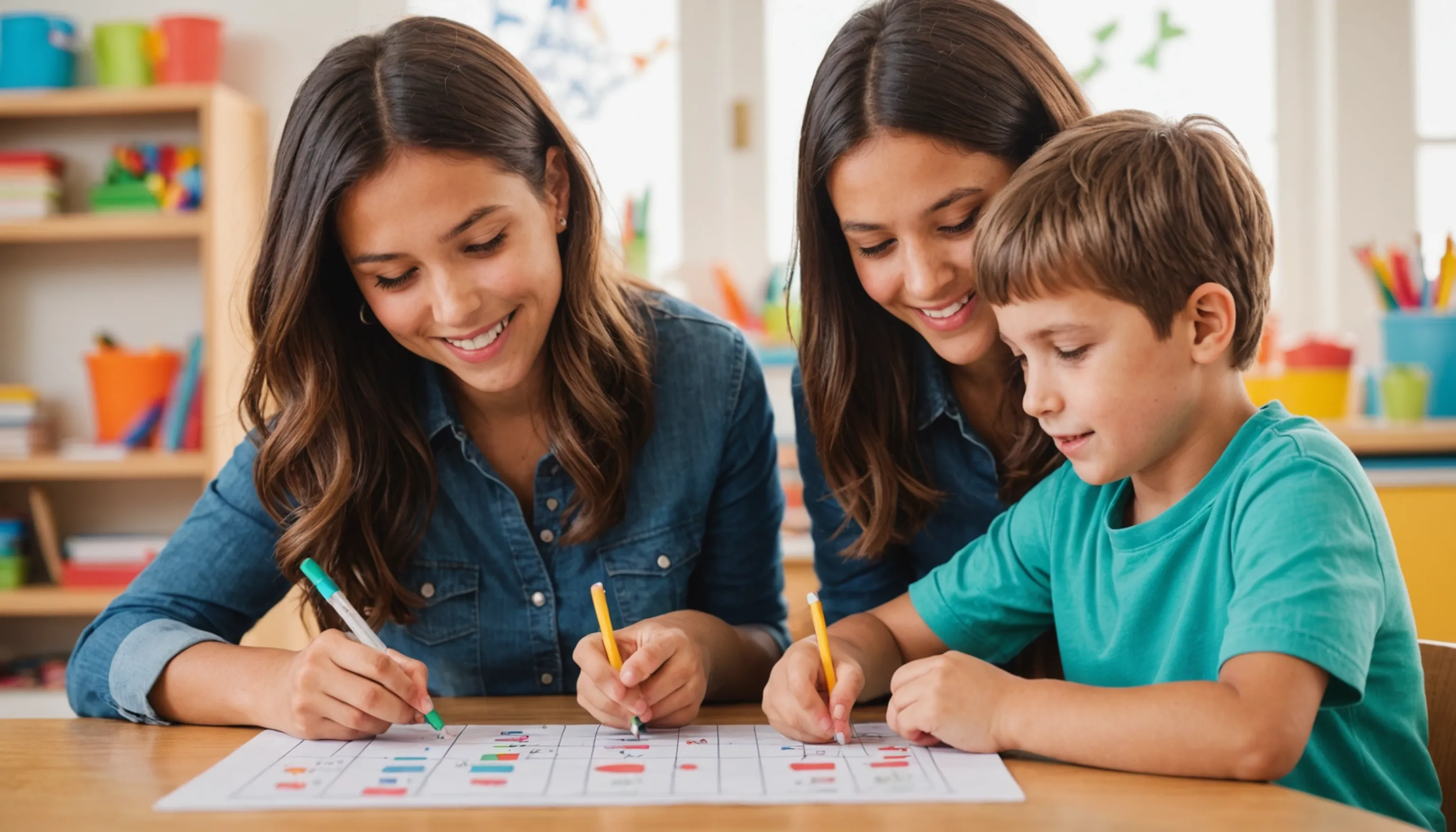Fun Ways to Teach Math to Kids
 HvWHenry van Wagenberg
HvWHenry van Wagenberg
Fun Ways to Teach Math to Kids
Teaching math to kids can be enjoyable with the right approach. Fun ways to teach math include using games, technology, and hands-on activities that engage children. For example, integrating math into everyday situations, like cooking or shopping, makes the subject relatable. You can also use apps that turn math practice into a fun challenge.
Outdoor activities, such as measuring distances or counting natural objects, can bring math to life. Additionally, incorporating music and art into lessons can enhance creativity while reinforcing math concepts. Ultimately, making math fun helps kids develop a positive attitude towards learning.
Using Games to Make Math Fun
Using games to teach math is a fantastic way to make learning enjoyable and engaging for kids. Incorporating math games into lessons can significantly enhance a child's understanding and retention of mathematical concepts. Here are some effective ways to use games to make math fun:
- Board Games: Traditional board games like Monopoly or Chutes and Ladders can be adapted to incorporate math skills such as counting, addition, and money management.
- Card Games: Simple card games like Uno can help with number recognition and strategic thinking while practicing addition or subtraction.
- Online Math Games: There are numerous educational websites and apps that offer interactive math games that are both fun and educational. These platforms often provide instant feedback, helping kids learn from their mistakes.
- Math Bingo: Create bingo cards with math problems instead of numbers. As problems are called out, children can solve them and mark their answers.
- Math Relay Races: Organize a relay race where kids solve math problems at various stations. This encourages teamwork and physical activity while reinforcing math skills.
Games not only make math more enjoyable but also foster a collaborative learning environment. They can help children build confidence in their math abilities while developing critical thinking and problem-solving skills. By incorporating games into math lessons, parents and teachers can create a positive learning experience that encourages a lifelong love of math.
Incorporating Technology and Apps
In today's digital age, incorporating technology and apps into math education can significantly enhance the learning experience for kids. With the right tools, parents and teachers can make math learning more interactive and engaging. Here are some effective ways to use technology in teaching math:
- Educational Apps: There are countless apps designed specifically to teach math concepts through fun and interactive games. Apps like Prodigy Math and Khan Academy Kids offer personalized learning experiences that adapt to each child's skill level.
- Online Math Platforms: Websites such as IXL and Mathletics provide a plethora of practice problems and instant feedback, allowing kids to work at their own pace. These platforms often gamify learning, making it more appealing.
- Virtual Manipulatives: Tools like virtual base ten blocks or number lines can help kids visualize math concepts. These manipulatives allow for hands-on learning in a digital format.
- Interactive Whiteboards: In the classroom, using interactive whiteboards can make math lessons more dynamic. Teachers can display problems, draw diagrams, and engage students in real-time.
- YouTube Tutorials: Many educators create video tutorials that explain math concepts in relatable ways. Parents can use these resources to support their children outside of school.
By integrating technology into math education, kids are more likely to stay engaged and motivated. The interactive nature of these tools helps reinforce concepts and encourages independent learning, laying a strong foundation for future math success.

Hands-On Activities for Engaging Learning
Hands-on activities are an excellent way to make learning math engaging and enjoyable for kids. By actively involving students in their learning process, these activities help them grasp mathematical concepts more effectively. Here are some creative hands-on activities that can enhance math education:
- Measurement Activities: Use measuring tapes or rulers to have kids measure different objects around the classroom or home. They can record their findings and practice skills like addition and subtraction by calculating the total lengths.
- Math Scavenger Hunt: Create a scavenger hunt where children must solve math problems to find clues. This activity promotes critical thinking and makes learning dynamic.
- Building Projects: Encourage kids to use blocks or LEGO sets to create structures. They can learn about geometry and spatial awareness while developing their engineering skills.
- Cooking Projects: Involve kids in cooking or baking to practice measurements, fractions, and conversions. Recipes provide real-life applications of math, making learning more relatable.
- Math Art: Integrate art into math lessons by having students create geometric shapes or patterns. This activity combines creativity with math concepts and allows for exploration of symmetry and design.
These hands-on activities not only make math enjoyable but also promote collaboration and communication among students. By connecting mathematical concepts to real-world experiences, children develop a deeper understanding and appreciation for the subject, fostering a positive attitude towards math.
Real-Life Applications of Math
Understanding the real-life applications of math is crucial for kids, as it helps them see the relevance of what they learn in school. Everyday situations provide excellent opportunities to practice math skills. For instance, when shopping, children can calculate discounts, compare prices, or manage a budget. Cooking offers a chance to explore measurements and fractions while preparing meals. Even simple activities like planning a road trip can teach kids about distance, time, and speed. By connecting math to real-world scenarios, kids develop problem-solving skills and a deeper appreciation for the subject, making learning both practical and enjoyable.
Cooking and Baking as Math Lessons
Cooking and baking provide a fantastic opportunity to teach kids math in a fun and practical way. By incorporating math lessons into the kitchen, parents and educators can help children understand essential concepts while enjoying delicious outcomes. Here are some effective ways to use cooking and baking to enhance math skills:
- Measurements: Cooking involves various measurements, such as cups, teaspoons, and ounces. Kids can learn about volume and weight by measuring ingredients for a recipe. This hands-on experience reinforces their understanding of fractions and conversions.
- Proportions: When adjusting recipes to serve more or fewer people, children can practice their skills in proportions. For instance, doubling a recipe requires them to multiply each ingredient, while halving it involves division.
- Time Management: Following a recipe involves timing. Kids can learn to read clocks and understand elapsed time by tracking cooking times and coordinating multiple tasks simultaneously.
- Temperature: Cooking at different temperatures introduces kids to concepts of degrees and can spark discussions about measurement scales, such as Celsius and Fahrenheit.
- Problem Solving: When things don’t go as planned in the kitchen, kids must think critically to find solutions, whether it’s correcting a recipe mistake or figuring out how to salvage a dish.
By integrating cooking and baking into math lessons, children not only develop their culinary skills but also gain practical knowledge that will serve them throughout their lives. This approach to learning fosters a positive attitude towards math and creates lasting memories in the kitchen.

Shopping and Budgeting Activities
Shopping and budgeting activities are excellent ways to teach kids essential math skills in a real-world context. These activities help children understand the value of money while reinforcing concepts like addition, subtraction, multiplication, and division. Here’s how to use shopping and budgeting to make math engaging:
- Shopping Lists: Involve kids in creating shopping lists for groceries or other items. They can practice adding up the cost of each item, ensuring they stay within a budget. This activity teaches them about planning and prioritizing needs versus wants.
- Price Comparison: When at the store, challenge kids to compare prices of similar products. They can calculate which item offers the best value for money, encouraging critical thinking and decision-making skills.
- Using Coupons: Teach children about discounts and savings by incorporating coupons into shopping trips. Kids can learn to calculate the total cost after applying discounts, helping them understand percentages and money management.
- Budgeting Activities: Give children a set amount of money to spend on a shopping trip. They must make choices about what to buy while staying within their budget. This hands-on experience teaches them financial responsibility and the importance of making informed decisions.
- Real-Life Scenarios: Create role-playing activities where kids must buy items and manage their money, such as organizing a small store at home.
By incorporating shopping and budgeting activities, kids not only improve their math skills but also develop valuable life skills that will help them manage their finances in the future.
Outdoor Math Activities
Outdoor math activities are a fantastic way to engage kids while allowing them to explore mathematical concepts in a fun and interactive environment. By taking math lessons outside, children can connect with nature and apply their skills in real-world scenarios. Here are some effective outdoor math activities:
- Measuring Distances: Equip kids with measuring tapes or yardsticks to measure the length of different objects, such as playground equipment or trees. This activity helps them practice measurement skills while learning about units and conversions.
- Nature Scavenger Hunt: Create a scavenger hunt that requires kids to find and count specific items in nature, such as leaves, rocks, or flowers. They can collect data and create graphs based on their findings, reinforcing their understanding of statistics and data representation.
- Geometry in the Park: Organize a geometric shape hunt in a local park. Ask kids to identify and classify shapes found in the environment, such as circles, squares, and triangles. This promotes spatial awareness and reinforces geometry concepts.
- Outdoor Games: Incorporate math into outdoor games like hopscotch or relay races that involve solving math problems at different stations. This encourages teamwork while making learning active and enjoyable.
- Gardening Projects: Involve kids in gardening, where they can calculate areas for planting, measure growth, and even learn about fractions when dividing space for different plants.
These outdoor math activities not only make learning fun but also encourage physical activity and exploration. By connecting math to the environment, children develop a deeper understanding of concepts while enjoying the great outdoors.
Creative Arts and Math Integration
Integrating creative arts with math education offers a unique way to engage kids while reinforcing mathematical concepts. Creative arts and math integration can include activities like using geometric shapes to create artwork, allowing students to explore symmetry, patterns, and spatial reasoning. Dance can also be a method to teach concepts like rhythm and counting, while music incorporates patterns and fractions in song structures. Furthermore, visual arts, such as painting or sculpting, can help kids understand measurements and proportions. This blend of creativity and math not only makes learning enjoyable but also enhances critical thinking and problem-solving skills.
Using Music to Teach Math Concepts
Using music to teach math concepts is a powerful and engaging method that can captivate children's attention while reinforcing essential skills. Music naturally incorporates various mathematical elements, making it an effective tool for educators and parents. Here are some ways to integrate music into math education:
- Rhythm and Patterns: Music is built on rhythm, which can help children understand patterns and sequences. By clapping hands or tapping feet to the beat, kids can learn to recognize and create rhythmic patterns, enhancing their understanding of repetition and sequencing.
- Counting Songs: Incorporate counting songs into lessons to help children practice counting and basic arithmetic. Songs that involve numbers can make learning more enjoyable and memorable, as melodies often help with retention.
- Fraction Rhythms: Teach fractions through music by using different note values. For example, whole notes, half notes, and quarter notes can represent fractions, allowing students to visualize mathematical concepts in a musical context.
- Math-Related Lyrics: Create songs that incorporate math vocabulary or concepts. Writing lyrics that include addition, subtraction, or multiplication can help reinforce these ideas in a fun and creative way.
- Musical Instruments: Explore the math behind musical instruments, such as measuring sound waves and understanding frequencies. This hands-on approach allows kids to connect math with real-world applications.
By combining music and math, children can develop a deeper understanding of mathematical concepts while enjoying the creative process. This approach fosters a positive learning environment that encourages exploration and creativity.
Art Projects that Involve Math Skills
Art projects that incorporate math skills provide a unique opportunity for children to explore mathematical concepts while engaging in creative expression. These projects can make learning fun and meaningful, helping kids develop both artistic and analytical skills. Here are some effective art projects that involve math:
- Geometric Art: Encourage kids to create artwork using geometric shapes. They can explore concepts like symmetry, angles, and patterns by constructing designs with triangles, squares, and circles. This hands-on approach reinforces geometry knowledge while allowing for personal creativity.
- Fractional Art: Use colored paper or paints to teach fractions through art. Children can create a collage that represents different fractions using various colors or shapes, helping them visualize how parts make up a whole.
- Graphing Art: Introduce graphing concepts by having kids create art based on coordinate planes. By plotting points on a grid and connecting them, they can produce designs like shapes or patterns while practicing their understanding of coordinates.
- Measurement in Art: Involve children in measuring materials for art projects, such as making sculptures or creating large murals. This activity teaches them about measurement units, area, and perimeter while enhancing their practical math skills.
- Pattern Making: Have kids design their own patterned artworks using stamps, stencils, or repeating motifs. This project encourages them to think about sequences and predictability, key concepts in math.
By integrating math skills into art projects, children can develop a deeper understanding of both subjects while fostering their creativity and critical thinking abilities.
